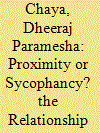| Srl | Item |
| 1 |
ID:
179141


|
|
|
|
|
| Summary/Abstract |
Several times a year, crowds gather at the Hazratbal Shrine near Srinagar to see the imam display a thermometer-like container that purportedly holds Prophet Muhammad’s hair.1 Located close to the summer capital in Jammu and Kashmir, the shrine–mosque complex is a symbol of prestige and famous throughout India. More than that, it has also repeatedly been the site of violent disturbances connected to militants seeking independence from India.2 One of the most tantalizing events surrounding the shrine is a little investigated, but widely retold story about the hair being stolen and returned during the early 1960s. The narrative about the theft from India’s top intelligence officer has been repeated but has not been previously examined from an intelligence studies lens. This article calls for a rethinking of the story and demonstrates how a careful reading of an intelligence officer’s memoir can potentially reveal new facts in light of fictional material.
|
|
|
|
|
|
|
|
|
|
|
|
|
|
|
|
| 2 |
ID:
188183


|
|
|
|
|
| Summary/Abstract |
Scholars of Intelligence Studies have extensively debated the contours of an ideal relationship between intelligence services and policy making, in which agencies can maintain analytical objectivity while having a policy impact. However, this debate has not meaningfully embraced a geographic expanse covering the Global South. This article, firstly, addresses this by offering a comprehensive analysis of the intelligence–policy relationship in India during the Nehruvian era. Secondly, it draws on the existing scholarly examinations of the global intelligence–policy relationships and argues that ‘proximity’ produces varying results in different decision-making cultures. Thirdly, the article contributes to the literature on contemporary Indian security by examining the impact on Indian intelligence of the relationship between Prime Minister Jawaharlal Nehru and B.N. Mullik, former chief of Indian intelligence and an understudied personality. It challenges the popular perception surrounding Mullik’s ‘sycophancy’ and argues that the decision-making culture that existed during the Nehruvian years demanded greater proximity, subservience and, in the worst case, sycophancy. A cost-benefit analysis presented in the article reveals that there were both pros and cons to the ‘proximity’ factor, with the former being more significant.
|
|
|
|
|
|
|
|
|
|
|
|
|
|
|
|